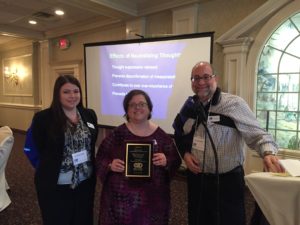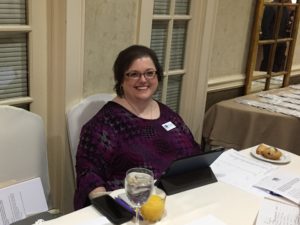OCDNJ 2018 Annual Conference Review
Martin Franklin, Ph.D. Presented on
“From the cradle to the grave: Nuances in CBT delivery across the developmental spectrum”
by Rachel Strohl, Psy.D.
 On Sunday March 4, 2018, Martin Franklin, Ph.D. presented at the annual conference of OCDNJ. He is an Associate Professor of Clinical Psychology in Psychiatry at the University of Pennsylvania, and Director of the Child and Adolescent OCD, Tic, Trich, and Anxiety Group (COTTAGe) in the Department of Psychiatry. Dr. Franklin received his Ph.D. in clinical psychology from the University of Rhode Island. He has devoted his career to the study of anxiety and body-focused repetitive behaviors (such as chronic tic disorders and trichotillomania, TTM) in children and adults. His clinical and research careers have centered on these disorders, with a particular emphasis on developing and disseminating effective treatments. Dr. Franklin has published theoretical, clinical and empirical papers and chapters, as well as treatment manuals. He is a clinical supervisor at the University of Pennsylvania for psychology interns and for residents and fellows in psychiatry, and continues to maintain a very active clinical practice in which he provides CBT to children, adolescents, and adults suffering from anxiety and related conditions.
On Sunday March 4, 2018, Martin Franklin, Ph.D. presented at the annual conference of OCDNJ. He is an Associate Professor of Clinical Psychology in Psychiatry at the University of Pennsylvania, and Director of the Child and Adolescent OCD, Tic, Trich, and Anxiety Group (COTTAGe) in the Department of Psychiatry. Dr. Franklin received his Ph.D. in clinical psychology from the University of Rhode Island. He has devoted his career to the study of anxiety and body-focused repetitive behaviors (such as chronic tic disorders and trichotillomania, TTM) in children and adults. His clinical and research careers have centered on these disorders, with a particular emphasis on developing and disseminating effective treatments. Dr. Franklin has published theoretical, clinical and empirical papers and chapters, as well as treatment manuals. He is a clinical supervisor at the University of Pennsylvania for psychology interns and for residents and fellows in psychiatry, and continues to maintain a very active clinical practice in which he provides CBT to children, adolescents, and adults suffering from anxiety and related conditions.
Dr. Franklin began by presenting the obsessive compulsive cycle: obsessions (repetitive, negative images or impulses) lead to distress (e.g., anxiety, fear, disgust, or shame) which lead to compulsions (repetitive thoughts, images, or actions). The compulsions provide negative reinforcement because relief occurs, but it’s only temporary, and the cycle of OCD continues. OCD in children manifests differently than adults: 1) children may be less likely to describe feared consequences, 2) more likely to engage in reassurance seeking with family members, 3) school can be a source of stress and “contamination,” and 4) more magical content.
With children it is important for the therapist to assess their knowledge base, in regards to their particular obsessions. He also recommended administering the CY-BOCS, which is an objective measure of OCD symptom severity. Comorbidity, in which a person has other diagnoses in addition to OCD, is common in adults and children, but more common in adults. Depression is more common for adults, and another anxiety disorder is most common in both.
Dr. Franklin reviewed the empirically supported treatment for OCD. CBT (cognitive behavioral therapy) for adult OCD studies found greater reduction of Y-BOCS scores than SRIs (serotonin reuptake inhibitors) for adult OCD. CBT maintained gains following discontinuation, while relapse can occur upon SRIs discontinuation. CBT causes initial distress and is not readily available, while SRIs have side effects for some patients. Combined treatments (CBT + SRIs) do not impede single therapies, and combined treatment is generally not superior to CBT. The outcomes of CBT and SRIs for pediatric OCD have similar outcomes as adult.
It was emphasized the importance of “pitching” CBT to patients with OCD and their families, which includes outcome data, theoretical rationale for treatment, factors contributing to good and poor outcomes, and specific examples of the application of CBT (e.g., if you can’t do this, what can you do in exposure). For adults, it is key to explain that “when you do compulsions, you deny yourself the opportunity to see that 1) anxiety won’t persist forever, 2) feared outcomes are highly unlikely to occur, and 3) when you value your comfort over your functioning, eventually you will have neither.” A simplified approach includes doing the thing you’re afraid of, the more you do it, the easier it gets.
For pitching CBT to children, it is important to 1) use their metaphors and age appropriate language, 2) consider what do they have to gain?, 3) rewards for participation and effort, and 4) emphasize “I won’t make you do anything.”
Dr. Franklin reviewed the core elements of a CBT protocol: 1) psychoeducation and cognitive training, 2) mapping OCD and developing treatment hierarchies, 3) exposure and response prevention (ERP), relapse prevention, and involvement of parent/ family members. A typical adult ERP session includes review of homework (10 mins), ERP (40 mins), and discuss and agree on homework (10 mins). A typical child ERP session would include some decreased times above, plus the child summarizes session to parent (10 min). The development of the exposure hierarchy includes the use of SUDS (subjective units of discomfort from 0 to 10).
Reframing and distancing in ERP includes recognizing and separating “own logical self from OCD and externalizing OCD,” reducing emotional importance given to thoughts, and reducing thought suppression efforts. There are two types of exposure: in vivo exposures during session and homework, and imaginal exposures. Both are done in a graded manner. Relapse prevention includes review of progress and future challenges, reinforcement of new knowledge, and the relationship between OCD and stress.
He concluded the presentation by providing an overview of implementing CBT with children and adolescents. Developmental considerations were discussed with specific examples, as well as stylistic considerations (e.g., focus on “choosing to be anxious” and “increasing risk tolerance”). Throughout the day, Dr. Franklin served as a charismatic, humorous, and engaging speaker. His use of case examples brought the practical treatment of OCD to life for the audience members.

The conference continued with an emotional highlight: the Living with OCD panel moderated by Dr. Weg. The panel consisted of an 18 year old female who is a senior in high school and remembers having OCD since age 3. She recalls symmetry obsessions and needing to ritualize by knocking on wood seven times for fear that her dad would be in an accident. She discussed also being diagnosed with trichotillomania, skin picking, and body dysmorphia. Support from her ERP therapist allowed her to do exposure and sit with uncertainty. Despite her obstacles, she stated with pride that she’s going to college with a presidential scholarship and has a supportive boyfriend/ close friends who help her stand up to her OCD.
A 19 year old male who is a senior in high school, and recalls at a very young age, washing his hands over and over again. He discussed mental compulsions to check for bad thoughts, obsessions involving morality and suicidality, and intense anxiety and social anxiety. He made great progress reducing his symptoms at a residential treatment center, and then maintained his gains against OCD with individual, weekly CBT. Currently, he’s able to stand up to OCD by taking a public speaking class as exposure.

A young adolescent female who experienced “just right” OCD and compulsions of asking teachers 5 times when something is over. She said OCD rules included “5 is a good number, even numbers, and orange is good too.” She recalled her fear of contamination, getting flushed by the toilet, needing to look perfect to be liked, and writing something wrong and needing to erase it. With exposure therapy, she’s now able to play in dirt, do her math homework in pen, hear her parents tell her they don’t love her for exposure exercises, and get along with her sister.

A 12 year old female who is in 7th grade who has had OCD since age 5. She remembered needing to wash her hands till they cracked and bled, crying a lot, unable to do things alone, needing to shower 3 times a day, and avoiding certain peers. She stated proudly that she doesn’t wash her hands all the time now, and was able to go to Disney and “have the best trip ever, unlike when I went at 10 and it was the worst trip ever.”
A 12 year old male who said his OCD was around his whole life starting at age 10. He recalls washing his hands too much and couldn’t touch many things, like the floor or batteries. He said CBT really helped him with “exposure therapy for my germaphobia,” because currently he could touch “dirty” things without hand washing. His grades improved because he was able to get to sleep earlier without ritualizing. The “OCD routines were hurting me in a negative way, and OCD was hurting me, versus the things it was telling me.” During the talk, he touched the floor proudly and received a enthusiastic round of applause.

A 15 year old female who is a freshman in high school who had severe OCD, emetophobia, separation anxiety, and social anxiety. She remembers being afraid to vomit without her mother so in 5th grade, she was doing 50 rituals in attempts to prevent the vomiting. After working with several therapists, she found a CBT therapist who was a good fit. She learned that exposure therapy works for her, and she’s able to ignore her OCD and anxiety (“fight or flight”). Instead of texting her mother 75 times a day with worries, she limits her text to 5. Some of her exposure exercises including spitting up Pirate Booty food with reduced fear of throwing up, and challenging social anxiety by now observing people in the school halls.
Each shared their brave experiences living with OCD, and then audience members asked the panel questions about a variety of topics. As in previous years, the panel members encouraged, informed, and offered hope to the individuals with OCD, their loved ones, and the professionals that treat them.




Dr. Rachel Strohl is a licensed psychologist at Stress and Anxiety Services of NJ in East Brunswick. She is on the Board of Directors at OCD New Jersey. She may be reached at 732-390-6694.
